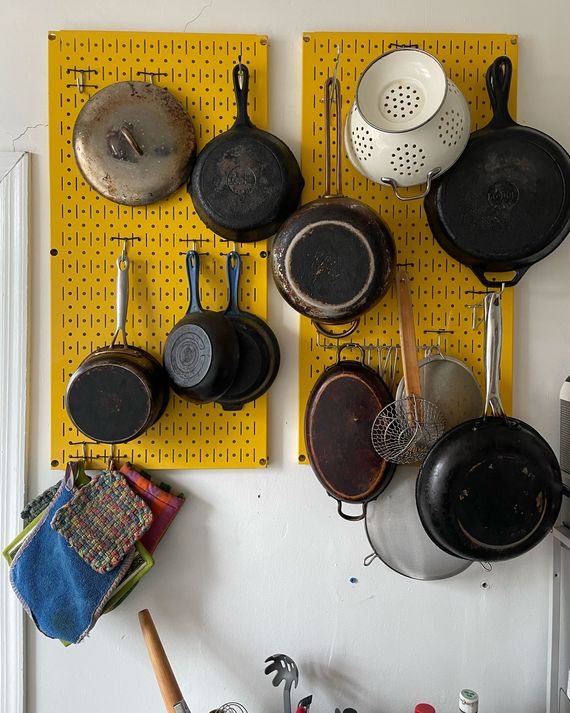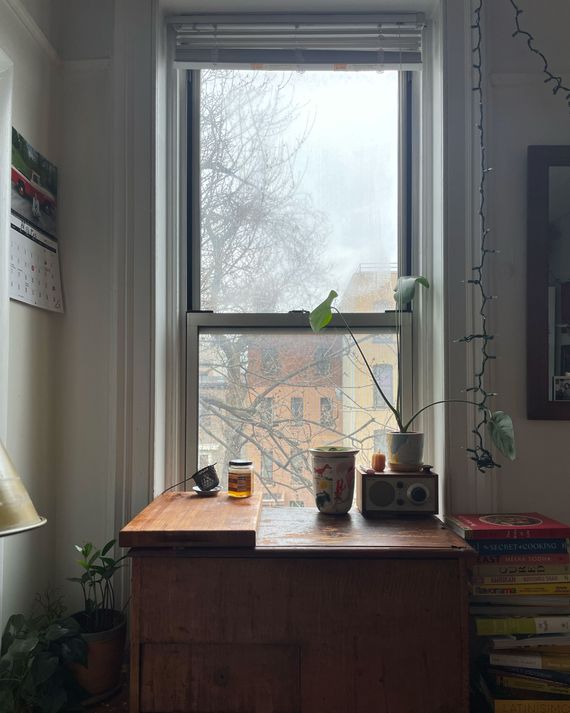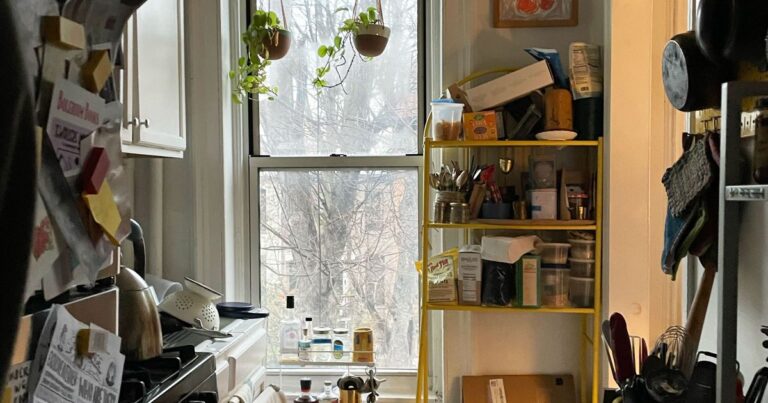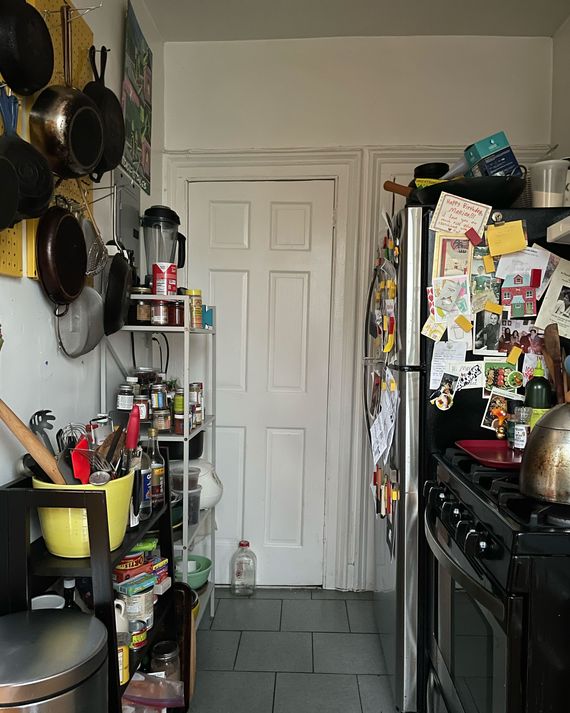
I've been living in a small kitchen for almost seven years now. Countertops. My kitchen is a standard galley, with a straight line of sink, stove, and refrigerator, facing a cluttered, overstuffed shelf. The narrow space between them is usually too small for more than one person. The kitchen had made me hesitant to use the space—I'm a hoarder and a food writer, after all—but the bright light, clawfoot tub, and tiny half-bedroom next to the bedroom convinced me to instead fit my messy cooking life into the tiny 35 square feet. Now I fly around the space like a pinball, choreographing my desires in the few feet of space between cutting board, stove, sink, and shelf, rehearsing a solo dance.
My kitchen — my kitchen and part of the living room I've added as an extension of the kitchen — has little work space and lots of storage space. It's a balance between scarcity and abundance. While I was building the space, I had to decide what I absolutely needed to have everything I wanted. On the wall facing the stove, there's a pair of yellow pegboards with three cast-iron skillets, a colander, two small and one medium pots, potholders, strainers, and assorted lids. These pots and pans can boil pasta, simmer tomato sauce, and deep-fry pork chops and thick slices of bread. In the smallest pot, I've gotten into the habit of parboiling vegetables, boiling instant noodles, and then poaching eggs appropriately. It's a meal that doesn't require cutting. I attach my knives to a magnetic strip on the stove and take small risks on a daily basis. My cabinets (three doors) hold mugs, bowls, plates, and wine cups. In the space between them and the ceiling are my grandmother's Dutch oven, a blue stockpot, and a stand mixer (the stand mixer was something I got for free at a previous job, so I can't give it away even though I rarely use it).


With no actual countertop, the cooking space is an inherited antique cabinet (a commode, to be exact) repurposed as a meat-cutting station, tucked into a corner of the living room just off the kitchen. Half of it is taken up by a giant cutting board, and the tiny radio in the back corner could use some rid of it, but turning on WBGO while brewing a cup or three of tea in the morning is just too pleasant, and utilitarianism has its limits. Next to the radio is a long, narrow ceramic bin where I put my daily compost. Onions, garlic, bananas, winter squash, etc., I keep on the dining table within reach of the commode (I move them to the nearest pile of books when guests come over). In terms of pure functionality, the only thing more important than the commode is an old high-school lunch tray that covers half the stove. (When I was a senior in high school, the school threatened to remove lunch trays from the cafeteria to minimize food waste, and being little kids, we stole trays in protest.) Here, bottles of condiments ready to pour, spices ready to be pinched, bowls of chopped garlic and ginger and carrots are arranged like synchronized swimmers about to dive.
Miserain placement (the act of cutting, portioning, peeling, and arranging ingredients before cooking begins) is especially important in a small kitchen. If the kitchen is not elegant, the movements within it must be. I slice a long eggplant on the cutting board, transfer it to a bowl, glide over to the stove, and place the bowl on a tray. I grab five bottles of ingredients to measure into the sauce, and when a thick, mushy mixture forms in the bowl, I stir it with a fork and transfer it to the tray, making a mess in the toilet before cleaning up. The tray fills with beer mugs and wooden spoons, eggplant and stir-fry sauce, and small bowls with ginger, garlic, and crushed dried chilies.
While cleaning I often think of the kitchen as a set of lungs that expand when it's messy and contract when it's tidy. And cleaning, like breathing, is constant. The sink fills and empties. (I was recently gifted an over-sink drying rack, which is particularly efficient; before that I used a sheet of metal painted white that came with my apartment.) The toilet fills and empties. The tray fills and empties. Sometimes everything is full, and when it is, it's dreadful. The only solution is to clear things out. But this constant change is the joy of cooking, the joy of having a kitchen. It's about making your space and getting to know it, tracking its growth, caring for it, cleaning when necessary.
Photo: Marianne Bull
About once a month, I push my kitchen to its limits. I invite three or four people over for dinner (the maximum number of people I can fit at the table without having to sit on the floor) and prepare a sumptuous meal using three or four different recipes. I set aside an afternoon to spread out prep items on the dining table, and sometimes the coffee table: bowls of chopped veggies, marinated tofu, reluctantly mixed dough. This takes longer than I expect, and it always drives me a little crazy and makes me wish I wasn't like that person. But I think it's important to see for yourself what's possible in the kitchen.
The endless space of the kitchen can sometimes be mistaken for a room that requires something like mastery. If you have a big kitchen We think, I'm the type of person who likes to cook treats.
Nancy Meyers' kitchen features a spacious double island, marble clad, and the luxury of a home. Serious about cooking Over the past decade, Ang Lee's Kitchen Eat Drink Man Woman The film opens with one of the greatest cooking scenes in cinema history, as a Taipei father prepares Sunday dinner for his daughters. He guts and fillets live fish, slices pork belly and radish, stuffs and steams endless dumplings, washes piles of vegetables, and boils a chicken that until recently lived in an alleyway. The kitchen is simple, but it is clearly the father's; his body moves seamlessly from one operation to the next, like muscle memory. I always go back to the round meat cutting board that's belly-over from years of cutting and pounding meat. My meals are smaller, but this is the hardworking energy I try to cultivate in my space. A place chock-full of possibility, brimming with practicality. The pots aren't hung there to look pretty, but because that's exactly where they should be. It's not built into the kitchen, it's built to be. Expectations Culinary Throughout life It's packed with practical items and made to be enjoyed in abundance.
See all



